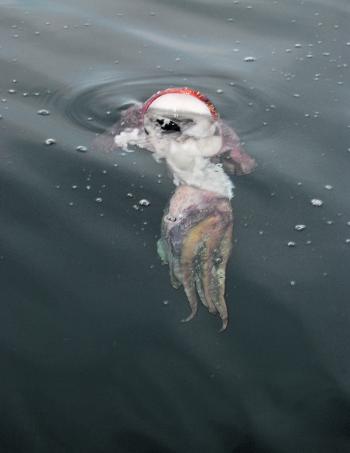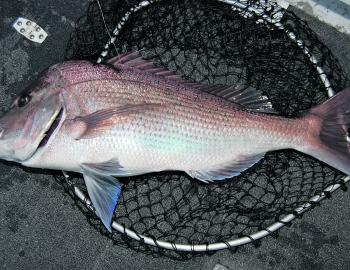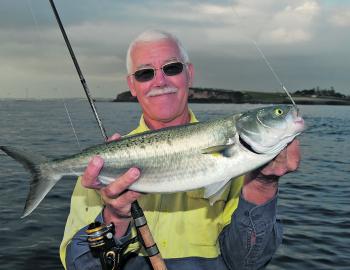This is it, we are right in the middle of snapper season all along the Illawarra coast. The new moon is at the beginning of the month, and the full moon is on the 20 July, so those two weeks in between should be prime snapper time.
The morning high tides should fish well close to the new moon with the afternoons fishing better nearer to the full moon with the high tides later in the day.
At this time of the year, most methods work well but the top two are to either berley using cuttlefish for bait, or just look for the floating cuttlefish and cast unweighted baits – cuttlefish is best – at them.
It doesn’t happen every day, but the sight of two or three large snapper on the surface taking turns at grabbing hold of a spent cuttlefish and driving with their tails to drag the cuttlie down and tear a piece of flesh off is amazing.
Early mornings on weekdays with little boat traffic will work best, usually with a light westerly blowing, making conditions in close smooth and often only a few hundred metres from the shore. You can see the spray flying into the air from a kilometre away.
Rushing over to feeding snapper for a look won’t get you anywhere, this is where patience is a virtue as a very slow approach is the only way when they are on the surface. They may be feeding, but when up on top and in shallow water the danger sensors are still fine-tuned, and too much noise or speed will see them gone before you get anywhere near casting distance.
You can spot them from shore at times, but it hurts too much to look if you can’t get at them.
Approach into the wind so you blow away from the activity, so if you miss you can motor back and have another crack. Drifting onto them just puts them down.
Cast as close as you can to the cuttlie and leave the bail open so the line peels off the reel as you drift away, allowing the bait to sink down below naturally and if one grabs your bait the line will fly off the reel rapidly. Most times you won’t see snapper, only the floating dead cuttlie, often with a few albatross grabbing a feed, so spotting floaters and albatross and casting as you find them is the way to go.
Once you get into 10kg breaking strains or better, the strike rate goes right down. You might get the few fish you hook rather than loose one or two of the multitude you hook when using lighter lines, but it is much more fun on the light stuff.
You never know what will grab a piece of cuttlefish at the moment with anything from groper to kings all getting in on the act.
Plenty of bream are still hanging around the shallow bays and in the washes, around the headlands and islands with small pieces of cuttlefish great bait for these too. Salmon, tailor and trevally all come into the mix as they pick up the scraps left by the albatross and larger predators.
Further offshore, there have been the odd report of a yellowfin or two out around the shelf and beyond and the eagerly awaited arrival of the southern bluefin usually happens in July, but as usual they will be so far out when they get this far up the coast you will almost need to get your passport stamped. Heading 60km and more out in a small boat in winter is not a great idea for any fish, so make sure your boat is suitable for this venture.
Out around the shelf with the current backing off, the bottom fish will be worth a look with blue eye trevalla, gemfish and the odd hapuka lining up at the Kiama Canyons. Mako sharks often tax a few fish, but they can add to the fun.
For the close in bottom bouncers, there are still a few good-sized flathead about, but they’re not in any great numbers. The snapper are the main target with good catches falling to the drifters. The mowies and just about every type of reef fish has been sent into a frenzy with all the cuttlefish about, and if you like leatherjacket, now is the time to get out the long shank no. 4 hooks and drop down over any reef with a small piece of cuttlefish and pull them up with every drop. They are thick over the reefs at the moment.
Off the rocks, it is bread and butter fishing with bream, drummer and blackfish the main targets. Most of the headlands and washes have a few fish with cabbage weed and prawns being the prime baits for the drummer and blackfish and cuttlefish for everything else.
On the deeper ledges there are some solid salmon and a few trevally taking pilchards and some nice snapper during the late afternoon and early mornings.
On the beaches, there is still the odd mulloway popping up here and there but you have to work a little harder this month, but it is still worth the cold for a bronze slab.
Salmon are the mainstay for the beach anglers, with most good gutters holding fish early in the mornings, a few whiting are even about and they are whoppers, but getting worms is both difficult and will make you very cold. A few bream will round off the catches and over the coming weeks, and it is not uncommon to catch snapper in the surf, particularly if there is a bit of southeast in the wind. This blows the floating cuttlefish into the surf and the snapper will often follow them right in, usually if it is very overcast and rainy or during the evenings and nights.
For the estuaries, my advice would be to give it a miss. If you are desperate there will be a few bream in the lake along the edges of the weed beds and rocky shores of the islands and around the bridge. The feeder streams will throw up a few more bream later in the month around the snags.
Reads: 2658
This is what you are looking for, a floater. The albatross and the snapper will demolish it in a short time. This one has already been chewed on.

This is what it is about, a 7kg snapper taken from under a cuttlefish. These fish are fit and fat after gorging on cuttlefish.

When it gets tough in winter, you can always rely on a few salmon to show up.




